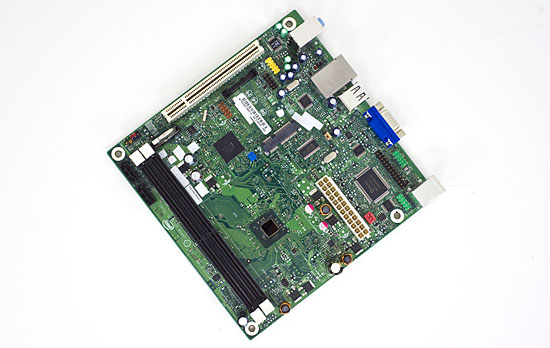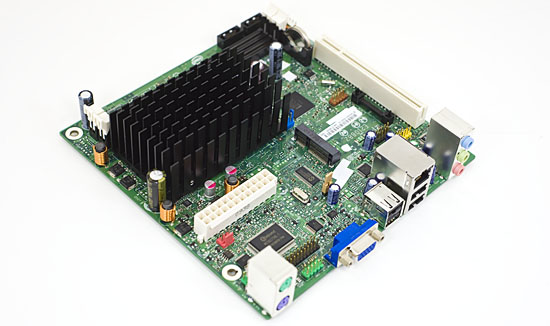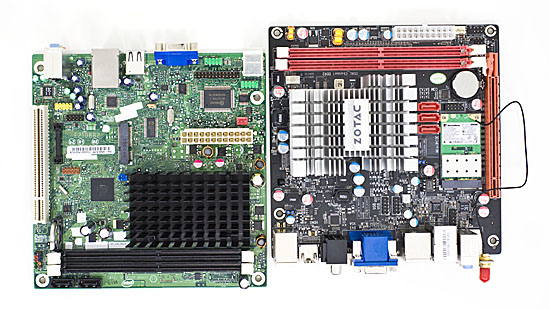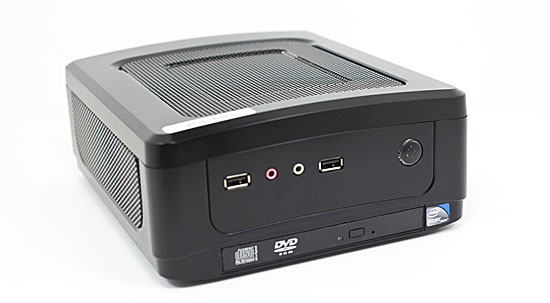Intel Atom D510: Pine Trail Boosts Performance, Cuts Power
by Anand Lal Shimpi on December 21, 2009 12:01 AM EST- Posted in
- CPUs
Meet the Board
We’ve got two Pine Trail articles for you today. I’m looking at the dual-core nettop version while Jarred is looking at the first Pine Trail netbook: ASUS’ EeePC 1005PE.
Intel sent me their first desktop Pine Trail motherboard: the D510MO(B). It’s a rather pedestrian looking mini-ITX design with a single 32-bit PCI slot (no PCIe) and a mini-PCIe socket on board.

Unlike previous desktop Atom motherboards, the D510MO(B) is entirely passively cooled. Here Intel is benefitting from the lower power characteristics of the Pine Trial platform, showoffs. You get a single large heatsink covering the Pineview Atom CPU, while the tiny NM10 sits naked outside.

Intel's Pine Trail board with heatsink
Another welcome change is the inclusion of two DIMM slots, despite Pineview only offering a single 64-bit DDR2 memory channel. You get two SATA ports as well.

Flip around to the rear of the board and the I/O panel is devoid of any excitement. Four USB ports, Ethernet, PS/2 keyboard/mouse, three 1/8” audio jacks and a VGA output are all you get. Granted the board only costs $75 new, but would it have killed Intel to include DVI or HDMI out? Let’s advance the industry folks, even at the low end.
I suspect that it’s more of a ploy from Intel to characterize Pine Trail as an entry level machine and not something you go around plugging into HDTVs, after all it can’t decode 1080p H.264 video. Leave those sorts of things to Ions.

Intel's Pine Trail desktop board (left) vs. Zotac's latest Ion board (right)
Intel stuck the D510MO(B) in a mini-ITX chassis equipped with its own external DC power supply to demonstrate its usefulness as a complete system. While not quite as sexy as the latest Ion platforms, it shows you exactly what you can do with one of these motherboards.

A fully passively cooled Pine Trail mini-ITX system
If you have a truly archaic desktop or want to add a third, fourth, fifth or fileserver PC to your network, grab one of these motherboards and using some relatively old/spare hardware you can build a functional machine. That’s the goal and in that capacity it works quite well. The cheapest Ion motherboards will run you over $110 and even then, in general usage tasks, they are actually slower. It’s only if you’re building a HTPC that Pine Trail disappoints, for a desktop or file server, you’re better off with Intel.











41 Comments
View All Comments
yuhong - Wednesday, December 30, 2009 - link
"Granted the board only costs $75 new, but would it have killed Intel to include DVI or HDMI out?"That is a limitation of the on-die GPU, it only support VGA and LVDS for the display.
lucaiuli - Saturday, January 2, 2010 - link
Found this board at http://www.mini-box.com/D510MO-mini-ITX-Intel">http://www.mini-box.com/D510MO-mini-ITX-Intel, it will be available this week, price is not bad. I am considering buying one and with a Broadcom Crystal HD miniPCI Express card and proper miniITX enclosure it would be a nice fanless and siled HD HTPC for my living room.geok1ng - Tuesday, December 22, 2009 - link
"It’s not a problem in areas where AMD is competitive, but what about areas in which they’re not?"AMD chose not to be competitive on the Netbook and lower power notebook market. There was a time when ATIs IGPs were very good, and today an overclocked 3200 can dish out enough fps to compete with NVIDIAs offerings. AMD had a lower power CPU months before the CLUVs, but it never become an integrated platform like Ion, even on the micro HTPC market.
If a company has a super IGP, and there was a time when AMD had one, and the market has a new wave of low power low costs Netbooks, and this company decides not to join the wave, well, dont blame Intel when things go the way of the Dodo.
I am only seeing Intel paying AMD so that Intel remains dominating the market, even on produtcs were Intel's offerings are so crappy as the IGP market.
Penti - Tuesday, December 22, 2009 - link
AMD still offers the AMD Neo X2 with AMD 785G or HD4200 graphics or with embedded AMD 780E + SB710 chipset. But that's not a netbook offering but a consumer or ultra-portable low-power notebook offer. I don't really like it that it's K8 based but it's still not totally bad. I don't think AMD is interested in the MID/smartphone market Intel is going after slowly any way.There's reason the AMD Neo platform didn't become a HTPC platform, first it was only released with 690E, secondly it wasn't supported in XBMC on linux. Then there's cost. Now CULV makes a lot more sense. GMA4500 is good enough. And it's first now supports really is coming through with Flash acceleration etc. It was a very limited usability with such a platform before. So soon Atom (with Broadcom accelerator), CULV etc really becomes useful and functional in the consumer space. AMD don't have any advantages even if they have support for the same things. I think it's wise that they are designing wholly new mobile products. Then there's gonna be a fair fight. Products will have a lower power envelope and be cheaper and on newer node. More will be released into the market.
killerclick - Monday, December 21, 2009 - link
This could be a chance for VIA Nano to get in on the netbook market. I fear however that most people buying netbooks won't know or care about the difference between the platforms. If it's cheap and can at least play 720p they won't go out of their way to get something non-Intel.Penti - Tuesday, December 22, 2009 - link
I won't consider the Nano until they have shrunk it, made it less power hungry, made it dual core and released a good graphics chip with truly open source drivers. I'd rather have Pineview + Broadcom BCM70015 if not.It's impressive what Centaur can do with ~100 employees, but I'm not impressed with the S3 Graphics or VIA chipset team.
killerclick - Tuesday, December 22, 2009 - link
I meant Nano + ATI/NVIDIA IGPPenti - Tuesday, December 22, 2009 - link
Yeah I know you wrote that. But..That will never happen. It's Nano + Mobile ATI/NVIDIA GPU tops. But I don't see the point. Via's own gpus are fine for DXVA in Windows etc. Nano aren't that power efficient to begin with. It's not like such platforms will be fast enough to game on either way.
This is what they have coming out (chipset with IGP) http://via.com.tw/en/products/chipsets/v-series/vn...">http://via.com.tw/en/products/chipsets/v-series/vn... It's not that bad. It has modern integrated graphics but it can be used with a discrete graphics solution too.
strikeback03 - Monday, December 21, 2009 - link
If I remember correctly, you used a standard ATX power supply for testing the LF/LF2 Atom boards, which you speculated was part of the reason for such high power consumption. Did you restest with the same PSU as from the Pine Trail system?Griswold - Monday, December 21, 2009 - link
Almost no performance gains - the opposite is actually true with the demise of useful chipset graphics for the atom platform.Buh bye, atom! Hello VIA Nano + ION!